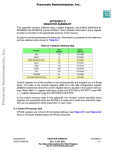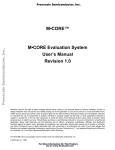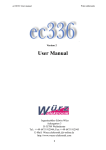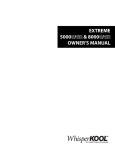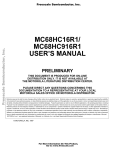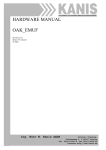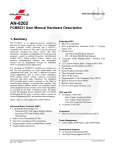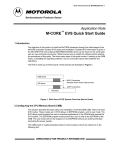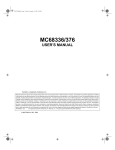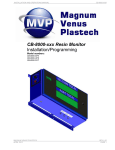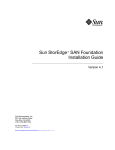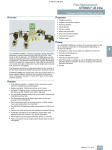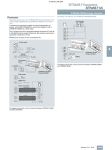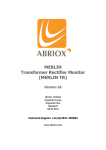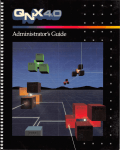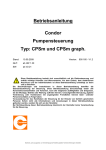Download SECTION 10 CONFIGURABLE TIMER MODULE 4
Transcript
SECTION 10 CONFIGURABLE TIMER MODULE 4 This section is an overview of CTM4 function. Refer to the CTM Reference Manual (CTMRM/AD) for a comprehensive discussion of CTM capabilities. 10.1 General The configurable timer module 4 (CTM4) consists of several submodules which are located on either side of the CTM4 internal submodule bus (SMB). All data and control signals within the CTM4 are passed over this bus. The SMB is connected to the outside world via the bus interface unit submodule (BIUSM), which is connected to the intermodule bus (IMB), and subsequently the CPU32. This configuration allows the CPU32 to access the data and control registers in each CTM4 submodule on the SMB. Three time base buses (TBB1, TBB2 and TBB4), each 16-bits wide, are used to transfer timing information from counters to action submodules. Figure 10-1 shows a block diagram of the CTM4. PCLK1 (fsys ÷ 2 or fsys ÷ 3) TIME BASE BUS 1 (TBB1) PULSE WIDTH MODULATION SUBMODULE (PWMSM8) CPWM8 PULSE WIDTH MODULATION SUBMODULE (PWMSM7) CPWM7 PULSE WIDTH MODULATION SUBMODULE (PWMSM6) CPWM6 PULSE WIDTH MODULATION SUBMODULE (PWMSM5) CPWM5 DOUBLE ACTION SUBMODULE (DASM10) CTD10 DOUBLE ACTION SUBMODULE (DASM9) CTD9 CLOCK PRESCALER SUBMODULE (CPSM) BUS INTERFACE UNIT SUBMODULE (BIUSM) LOAD MODULUS COUNTER SUBMODULE (MCSM11) FREE-RUNNING COUNTER SUBMODULE (FCSM12) MODULUS COUNTER SUBMODULE (MCSM2) TIME BASE BUS 4 (TBB4) TIME BASE BUS 2 (TBB2) DOUBLE ACTION SUBMODULE (DASM4) CTD4 DOUBLE ACTION SUBMODULE (DASM3) CTD3 EXTERNAL CLOCK CTM2C GLOBAL TIME BASE BUS A GLOBAL TIME BASE BUS B CTM4 BLOC Figure 10-1 CTM4 Block Diagram MC68336/376 USER’S MANUAL CONFIGURABLE TIMER MODULE 4 Rev. 15 Oct 2000 MOTOROLA 10-1 The time base buses originate in a counter submodule and are used by the action submodules. Two time base buses are accessible to each submodule. The bus interface unit submodule (BIUSM) allows all the CTM4 submodules to pass data to and from the IMB via the submodule bus (SMB). The counter prescaler submodule (CPSM) generates six different clock frequencies which can be used by any counter submodule. This submodule is contained within the BIUSM. The free-running counter submodule (FCSM) has a 16-bit up counter with an associated clock source selector, selectable time-base bus drivers, writable control registers, readable status bits, and interrupt logic.The CTM4 has one FCSM. The modulus counter submodule (MCSM) is an enhanced FCSM. A modulus register gives the additional flexibility of recycling the counter at a count other than 64K clock cycles. The CTM4 has two MCSMs. The double-action submodule (DASM) provides two 16-bit input capture or two 16-bit output compare functions that can occur automatically without software intervention. The CTM4 has four DASMs. The pulse width modulation submodule (PWMSM) can generate pulse width modulated signals over a wide range of frequencies, independently of other CTM output signals. PWMSMs are not affected by time base bus activity. The CTM4 has four PWMSMs. 10.2 Address Map The CTM4 address map occupies 256 bytes from address $YFF400 to $YFF4FF. All CTM4 registers are accessible only when the CPU32 is in supervisor mode. All reserved addresses return zero when read, and writes have no effect. Refer to D.7 Configurable Timer Module 4 for information concerning CTM4 address map and register bit/field descriptions. 10.3 Time Base Bus System The CTM4 time base bus system is composed of three 16-bit buses: TBB1, TBB2, and TBB4. These buses are used to transfer timing information from the counter submodules to the action submodules. Two time base buses are available to each submodule. A counter submodule can drive one of the two time base buses to which it is connected. Each action submodule can choose one of the two time base buses to which it is connected as its time base. Control bits within each CTM4 submodule select connection to the appropriate time base bus. The time base buses are precharge/discharge type buses with wired-OR capability. Therefore, no hardware damage occurs when more than one counter drives the same bus at the same time. MC68336/376 USER’S MANUAL CONFIGURABLE TIMER MODULE 4 Rev. 15 Oct 2000 MOTOROLA 10-2 In the CTM4, TBB2 is global and accessible to every submodule. TBB1 and TBB4 are split to form two local time base buses. Table 10-1 shows which time base buses are available to each CTM4 submodule. Table 10-1 CTM4 Time Base Bus Allocation Global/Local Time Base Bus Allocation Submodule Global Bus A Global/Local Time Base Bus Allocation Global Bus B Submodule Global Bus A Global Bus B DASM9 TBB1 TBB2 MCSM 2 TBB4 TBB2 DASM10 TBB1 TBB2 DASM 3 TBB4 TBB2 MCSM 11 TBB1 TBB2 DASM 4 TBB4 TBB2 FCSM 12 TBB1 TBB2 Each PWMSM has an independent 16-bit counter and 8-bit prescaler clocked by the PCLK1 signal, which is generated by the CPSM. The PWMSMs are not connected to any of the time base buses. Refer to 10.9 Pulse-Width Modulation Submodule (PWMSM) for more information. 10.4 Bus Interface Unit Submodule (BIUSM) The BIUSM connects the SMB to the IMB and allows the CTM4 submodules to communicate with the CPU32. The BIUSM also communicates CTM4 submodule interrupt requests to the IMB, and transfers the interrupt level, arbitration number and vector number to the CPU32 during the interrupt acknowledge cycle. 10.4.1 STOP Effect On the BIUSM When the CPU32 STOP instruction is executed, only the CPU32 is stopped; the CTM4 continues to operate as normal. 10.4.2 Freeze Effect On the BIUSM CTM4 response to assertion of the IMB FREEZE signal is controlled by the FRZ bit in the BIUSM configuration register (BIUMCR). Since the BIUSM propagates FREEZE to the CTM4 submodules via the SMB, the setting of FRZ affects all CTM4 submodules. If the IMB FREEZE signal is asserted and FRZ = 1, all CTM4 submodules freeze. The following conditions apply when the CTM4 is frozen: • All submodule registers can still be accessed. • The CPSM, FCSM, MCSM, and PWMSM counters stop counting. • The IN status bit still reflects the state of the FCSM external clock input pin. • The IN2 status bit still reflects the state of the MCSM external clock input pin, and the IN1 status bit still reflects the state of the MCSM modulus load input pin. • DASM capture and compare functions are disabled. • The DASM IN status bit still reflects the state of its associated pin in the DIS, IPWM, IPM, and IC modes. In the OCB, OCAB, and OPWM modes, IN reflects the state of the DASM output flip flop. MC68336/376 USER’S MANUAL CONFIGURABLE TIMER MODULE 4 Rev. 15 Oct 2000 MOTOROLA 10-3 • When configured for OCB, OCAB, or OPWM modes, the state of the DASM output flip-flop will remain unchanged. • The state of the PWMSM output flip-flop will remain unchanged. If the IMB FREEZE signal is asserted and FRZ = 0, the freeze condition is ignored, and all CTM4 submodules will continue to operate normally. 10.4.3 LPSTOP Effect on the BIUSM When the CPU32 LPSTOP instruction is executed, the system clock is stopped. All dependent modules, including the CTM4, are shut down until low-power STOP mode is exited. 10.4.4 BIUSM Registers The BIUSM contains a module configuration register, a time base register, and a test register. The BIUSM register block occupies the first four register locations in the CTM4 register space. All unused bits and reserved address locations return zero when read. Writes to unused bits and reserved address locations have no effect. Refer to D.7.1 BIU Module Configuration Register, D.7.2 BIUSM Test Configuration Register, and D.7.3 BIUSM Time Base Register for information concerning BIUSM register and bit descriptions. 10.5 Counter Prescaler Submodule (CPSM) The counter prescaler submodule (CPSM) is a programmable divider system that provides the CTM4 counters with a choice of six clock signals (PCLK[1:6]) derived from the main MCU system clock. Five of these frequencies are derived from a fixed divider chain. The divide ratio of the last clock frequency is software selectable from a choice of four divide ratios. The CPSM is part of the BIUSM. Figure 10-2 shows a block diagram of the CPSM. MC68336/376 USER’S MANUAL CONFIGURABLE TIMER MODULE 4 Rev. 15 Oct 2000 MOTOROLA 10-4 fsys FIRST CPSM PRESCALER PCLK1 = fsys÷ 2 fsys÷ 3 ÷2 OR ÷3 8-BIT PRESCALER ÷2 PCLK2 = fsys÷ 4 fsys÷ 6 ÷4 PCLK3 = fsys ÷ 8 fsys÷ 12 ÷8 PCLK4 = fsys÷ 16 fsys÷ 24 ÷16 PCLK5 = fsys÷ 32 fsys÷ 48 PCLK6 = fsys÷ 64 fsys ÷ 128 fsys ÷ 256 fsys÷ 512 fsys ÷ 96 fsys ÷ 192 fsys÷ 384 fsys÷ 768 DIV23 = ÷ 2 DIV23 = ÷ 3 ÷32 ÷64 ÷128 SELECT ÷256 PRUN DIV23 PSEL1 PSEL0 CPCR CTM CPSM BLOCK Figure 10-2 CPSM Block Diagram 10.5.1 CPSM Registers The CPSM contains a control register (CPCR) and a test register (CPTR). All unused bits and reserved address locations return zero when read. Writes to unused bits and reserved address locations have no effect. Refer to D.7.4 CPSM Control Register and D.7.5 CPSM Test Register for information concerning CPSM register and bit descriptions. 10.6 Free-Running Counter Submodule (FCSM) The free-running counter submodule (FCSM) has a 16-bit up counter with an associated clock source selector, selectable time-base bus drivers, control registers, status bits, and interrupt logic. When the 16-bit up counter overflows from $FFFF to $0000, an optional overflow interrupt request can be generated. The current state of the 16bit counter is the primary output of the counter submodules. The user can select which, if any, time base bus is to be driven by the 16-bit counter. A software control register selects whether the clock input to the counter is one of the taps from the prescaler or an input pin. The polarity of the external input pin is also programmable. In order to count, the FCSM requires the CPSM clock signals to be present. After reset, the FCSM does not count until the prescaler in the CPSM starts running (when the software sets the PRUN bit). This allows all counters in the CTM4 submodules to be synchronized. The CTM4 has one FCSM. Figure 10-3 shows a block diagram of the FCSM. MC68336/376 USER’S MANUAL CONFIGURABLE TIMER MODULE 4 Rev. 15 Oct 2000 MOTOROLA 10-5 TBBA Time base buses TBBB 6 clocks (PCLK[1:6]) from prescaler Bus select DRVADRVB Control register bits INPUT pin CTM2C Clock select Edge detect IN Overflow 16-bit up counter CLK2 CLK1 CLK0 Control register bits COF IL2 IL1 Interrupt control IL0 IARB3 Control register bits Submodule bus CTM FCSM BLOCK Figure 10-3 FCSM Block Diagram 10.6.1 FCSM Counter The FCSM counter consists of a 16-bit register and a 16-bit up-counter. Reading the register transfers the contents of the counter to the data bus, while a write to the register loads the counter with a new value. Overflow of the counter is defined to be the transition from $FFFF to $0000. An overflow condition sets the counter overflow flag (COF) in the FCSM status/interrupt/control register (FCSMSIC). NOTE Reset presets the counter register to $0000. Writing $0000 to the counter register while the counter’s value is $FFFF does not set the COF flag and does not generate an interrupt request. 10.6.2 FCSM Clock Sources The FCSM has eight software selectable counter clock sources, including: • Six CPSM prescaler outputs (PCLK[1:6]) • Rising edge on CTM2C input • Falling edge on the CTM2C input The clock source is selected by the CLK[2:0] bits in FCSMSIC. When the CLK[2:0] bits are being changed, internal circuitry guarantees that spurious edges occurring on the CTM2C pin do not affect the FCSM. The read-only IN bit in FCSMSIC reflects the state of CTM2C. This pin is Schmitt-triggered and is synchronized with the system clock. The maximum allowable frequency for a clock input on CTM2C is fsys/4. MC68336/376 USER’S MANUAL CONFIGURABLE TIMER MODULE 4 Rev. 15 Oct 2000 MOTOROLA 10-6 10.6.3 FCSM External Event Counting When an external clock source is selected, the FCSM can act as an event counter simply by counting the number of events occurring on the CTM2C input pin. Alternatively, the FCSM can be programmed to generate an interrupt request when a predefined number of events have been counted. This is done by presetting the counter with the two’s complement value of the desired number of events. 10.6.4 FCSM Time Base Bus Driver The DRVA and DRVB bits in FCSMSIC select the time base bus to be driven. Which of the time base buses is driven depends on where the FCSM is physically placed in any particular CTM implementation. Refer to Figure 10-1 and Table 10-1 for more information. WARNING Two time base buses should not be driven at the same time. 10.6.5 FCSM Interrupts The FCSM can optionally request an interrupt when its counter overflows and the COF bit in FCSMSIC is set. To enable interrupts, set the IL[2:0] field in the FCSMSIC to a non-zero value. The CTM4 compares the CPU32 IP mask value to the priority of the requested interrupt designated by IL[2:0] to determine whether it should contend for arbitration priority. During arbitration, the BIUSM provides the arbitration value specified by IARB[2:0] in BIUMCR and IARB3 in FCSMSIC. If the CTM4 wins arbitration, it responds with a vector number generated by concatenating VECT[7:6] in BIUMCR and the six low-order bits specified by the number of the submodule requesting service. Thus, for FCSM12 in CTM4, six low-order bits would be 12 in decimal, or %001100 in binary. 10.6.6 FCSM Registers The FCSM contains a status/interrupt/control register and a counter register. All unused bits and reserved address locations return zero when read. Writes to unused bits and reserved address locations have no effect. Refer to D.7.6 FCSM Status/ Interrupt/Control Register and D.7.7 FCSM Counter Register for information concerning FCSM register and bit descriptions. 10.7 Modulus Counter Submodule (MCSM) The modulus counter submodule (MCSM) is an enhanced FCSM. The MCSM contains a 16-bit modulus latch, a 16-bit loadable up-counter, counter loading logic, a clock selector, selectable time base bus drivers, and an interrupt interface. A modulus register provides the added flexibility of recycling the counter at a count other than 64K clock cycles. The content of the modulus latch is transferred to the counter when an overflow occurs, or when a user-specified edge transition occurs on a designated modulus load input pin. In addition, a write to the modulus counter simultaneously loads both the counter and the modulus latch with the specified value. The counter then begins incrementing from this new value. MC68336/376 USER’S MANUAL CONFIGURABLE TIMER MODULE 4 Rev. 15 Oct 2000 MOTOROLA 10-7 In order to count, the MCSM requires the CPSM clock signals to be present. After reset, the MCSM does not count until the prescaler in the CPSM starts running (when the software sets the PRUN bit). This allows all counters in the CTM4 submodules to be synchronized. The CTM4 contains two MCSMs. Figure 10-4 shows a block diagram of the MCSM. TBBA Time base buses TBBB 6 clocks (PCLK[1:6]) from prescaler Bus select CLOCK INPUT PIN CTM2C Clock select Edge detect DRVADRVB Control register bits IN2 CLK2 CLK1 CLK0 Control register bit Control register bits Overflow Interrupt control Modulus control Modulus load input pin CTML MODULUS LOAD INPUT PIN CTD9 16-bit up counter Modulus register Edge detect Write both IN1 Control register bit EDGENEDGEP COF Control register bits IL2 IL1 IL0 IARB3 Control register bits Submodule bus CTM MCSM BLOCK Figure 10-4 MCSM Block Diagram 10.7.1 MCSM Modulus Latch The 16-bit modulus latch is a read/write register that is used to reload the counter automatically with a predetermined value. The contents of the modulus latch register can be read at any time. Writing to the register loads the modulus latch with the new value. This value is then transferred to the counter register when the next load condition occurs. However, writing to the corresponding counter register loads the modulus latch and the counter register immediately with the new value. The modulus latch register is cleared to $0000 by reset. 10.7.2 MCSM Counter The counter is composed of a 16-bit read/write register associated with a 16-bit incrementer. Reading the counter transfers the contents of the counter register to the data bus. Writing to the counter loads the modulus latch and the counter register immediately with the new value. MC68336/376 USER’S MANUAL CONFIGURABLE TIMER MODULE 4 Rev. 15 Oct 2000 MOTOROLA 10-8 10.7.2.1 Loading the MCSM Counter Register The MCSM counter is loaded either by writing to the counter register or by loading it from the modulus latch when a counter overflow occurs. Counter overflow will set the COF bit in the MCSM status/interrupt/control register (MCSMSIC). NOTE When the modulus latch is loaded with $FFFF, the overflow flag is set on every counter clock pulse. 10.7.2.2 Using the MCSM as a Free-Running Counter Although the MCSM is a modulus counter, it can operate like a free-running counter by loading the modulus register with $0000. 10.7.3 MCSM Clock Sources The MCSM has eight software selectable counter clock sources, including: • Six CPSM prescaler outputs (PCLK[1:6]) • Rising edge on the CTM2C input • Falling edge on the CTM2C input The clock source is selected by the CLK[2:0] bits in MCSMSIC. When the CLK[2:0] bits are being changed, internal circuitry guarantees that spurious edges occurring on the CTM2C pin do not affect the MCSM. The read only IN2 bit in MCSMSIC reflects the state of CTM2C. This pin is Schmitt-triggered, and is synchronized with the system clock. The maximum allowable frequency for a clock signal input on CTM2C is fsys/4. 10.7.4 MCSM External Event Counting When an external clock source is selected, the MCSM can act as an event counter simply by counting the number of events occurring on the CTM2C input pin. Alternatively, the MCSM can be programmed to generate an interrupt when a predefined number of events have been counted. This is done by presetting the counter with the two’s complement value of the desired number of events. 10.7.5 MCSM Time Base Bus Driver The DRVA and DRVB bits in MCSMSIC select the time base bus to be driven. Which of the time base buses is driven depends on where the MCSM is physically placed in any particular CTM implementation. Refer to Figure 10-1 and Table 10-1 for more information. WARNING Two time base buses should not be driven at the same time. 10.7.6 MCSM Interrupts The MCSM can optionally request an interrupt when its counter overflows and the COF bit in MCSMSIC is set. To enable interrupts, set the IL[2:0] field in the MCSMSIC to a non-zero value. The CTM4 compares the CPU32 IP mask value to the priority of MC68336/376 USER’S MANUAL CONFIGURABLE TIMER MODULE 4 Rev. 15 Oct 2000 MOTOROLA 10-9 the requested interrupt designated by IL[2:0] to determine whether it should contend for arbitration priority. During arbitration, the BIUSM provides the arbitration value specified by IARB[2:0] in BIUMCR and IARB3 in MCSMSIC. If the CTM4 wins arbitration, it responds with a vector number generated by concatenating VECT[7:6] in BIUMCR and the six low-order bits specified by the number of the submodule requesting service. Thus, for MCSM12 in CTM4, six low-order bits would be 12 in decimal, or %001100 in binary. 10.7.7 MCSM Registers The MCSM contains a status/interrupt/control register, a counter, and a modulus latch. All unused bits and reserved address locations return zero when read. Writes to unused bits and reserved address locations have no effect. The CTM4 contains three MCSMs, each with its own set of registers. Refer to D.7.8 MCSM Status/Interrupt/ Control Registers, D.7.9 MCSM Counter Registers, and D.7.10 MCSM Modulus Latch Registers for information concerning MCSM register and bit descriptions. 10.8 Double-Action Submodule (DASM) The double-action submodule (DASM) allows two 16-bit input capture or two 16-bit output compare functions to occur automatically without software intervention. The input edge detector can be programmed to trigger the capture function on userspecified edges. The output flip flop can be set by one of the output compare functions, and reset by the other one. Interrupt requests can optionally be generated by the input capture and the output compare functions. The user can select one of two incoming time bases for the input capture and output compare functions. Six operating modes allow the DASM input capture and output compare functions to perform pulse width measurement, period measurement, single pulse generation, and continuous pulse width modulation, as well as standard input capture and output compare. The DASM can also function as a single I/O pin. DASM operating mode is determined by the mode select field (MODE[3:0]) in the DASM status/interrupt/control register (DASMSIC). Table 10-2 shows the different DASM operating modes. MC68336/376 USER’S MANUAL CONFIGURABLE TIMER MODULE 4 Rev. 15 Oct 2000 MOTOROLA 10-10 Table 10-2 DASM Modes of Operation MODE[3:0] Mode Description of Mode 0000 DIS 0001 IPWM 0010 IPM 0011 IC 0100 OCB 0101 OCAB 0110 — Reserved 0111 — Reserved 1xxx OPWM Disabled — Input pin is high impedance; IN gives state of input pin Input pulse width measurement — Capture on leading edge and the trailing edge of an input pulse Input period measurement — Capture two consecutive rising/falling edges Input capture — Capture when the designated edge is detected Output compare, flag set on B compare — Generate leading and trailing edges of an output pulse and set the flag Output compare, flag set on A and B compare — Generate leading and trailing edges of an output pulse and set the flag Output pulse width modulation — Generate continuous PWM output with 7, 9, 11, 12, 13, 14, 15, or 16 bits of resolution The DASM is composed of two timing channels (A and B), an output flip-flop, an input edge detector, some control logic and an interrupt interface. All control and status bits are contained in DASMSIC. Channel A consists of one 16-bit data register and one 16-bit comparator. To the user, channel B also appears to consist of one 16-bit data register and one 16-bit comparator, though internally, channel B has two data registers (B1 and B2). DASM operating mode determines which register is software accessible. Refer to Table 10-3. Table 10-3 Channel B Data Register Access Mode Data Register Input Capture (IPWM, IPM, IC) Registers A and B2 are used to hold the captured values. In these modes, the B1 register is used as a temporary latch for channel B. Output Compare (OCA, OCAB) Registers A and B2 are used to define the output pulse. Register B1 is not used in these modes. Output Pulse Width Modulation Mode (OPWM) Registers A and B1 are used as primary registers and hidden register B2 is used as a double buffer for channel B. Register contents are always transferred automatically at the correct time so that the minimum pulse (measured or generated) is just one time base bus count. The A and B data registers are always read/write registers, accessible via the CTM4 submodule bus. The CTM4 has four DASMs. Figure 10-5 shows a block diagram of the DASM. MC68336/376 USER’S MANUAL CONFIGURABLE TIMER MODULE 4 Rev. 15 Oct 2000 MOTOROLA 10-11 TBBA 2 time base buses TBBB Bus select FORCA FORCB BSL 16-bit comparator A Output flip-flop WOR IN Output buffer I/O pin 16-bit register A EDPOL 16-bit register B1 Edge detect Register B Interrupt control 16-bit register B2 16-bit comparator B MODE3 MODE2 MODE1 MODE0 FLAG Control register bits IL2 IL1 IL0 IARB3 Control register bits Submodule bus CTM DASM BLOCK Figure 10-5 DASM Block Diagram 10.8.1 DASM Interrupts The DASM can optionally request an interrupt when the FLAG bit in DASMSIC is set. To enable interrupts, set the IL[2:0] field in DASMSIC to a non-zero value. The CTM4 compares the CPU32 IP mask value to the priority of the requested interrupt designated by IL[2:0] to determine whether it should contend for arbitration priority. During arbitration, the BIUSM provides the arbitration value specified by IARB[2:0] in BIUMCR and IARB3 in DASMSIC. If the CTM4 wins arbitration, it responds with a vector number generated by concatenating VECT[7:6] in BIUMCR and the six low-order bits specified by the number of the submodule requesting service. Thus, for DASM9 in the CTM4, the six low-order bits would be nine in decimal, or %001001 in binary. 10.8.2 DASM Registers The DASM contains one status/interrupt/control register and two data registers (A and B). All unused bits and reserved address locations return zero when read. Writes to unused bits and reserved address locations have no effect. The CTM4 contains four DASMs, each with its own set of registers. Refer to D.7.11 DASM Status/Interrupt/ Control Registers, D.7.12 DASM Data Register A, and D.7.13 DASM Data Register B for information concerning DASM register and bit descriptions. MC68336/376 USER’S MANUAL CONFIGURABLE TIMER MODULE 4 Rev. 15 Oct 2000 MOTOROLA 10-12 10.9 Pulse-Width Modulation Submodule (PWMSM) The PWMSM allows pulse width modulated signals to be generated over a wide range of frequencies, independently of other CTM4 output signals. The output pulse width duty cycle can vary from 0% to 100%, with 16 bits of resolution. The minimum pulse width is twice the MCU system clock period. For example, the minimum pulse width is 95.4 ns when using a 20.97 MHz clock. The PWMSM is composed of: • An output flip-flop with output polarity control • Clock prescaler and selection logic • A 16-bit up-counter • Two registers to hold the current and next pulse width values • Two registers to hold the current and next pulse period values • A pulse width comparator • A system state sequencer • Logic to create 0% and 100% pulses • Interrupt logic • A status, interrupt and control register • A submodule bus interface The PWMSM includes its own time base counter and does not use the CTM4 time base buses; however, it does use the prescaled clock signal PCLK1 generated by the CPSM. Refer to 10.5 Counter Prescaler Submodule (CPSM) and Figure 10-1 for more information. Figure 10-6 shows a block diagram of the PWMSM. MC68336/376 USER’S MANUAL CONFIGURABLE TIMER MODULE 4 Rev. 15 Oct 2000 MOTOROLA 10-13 PCLK1 ÷256 prescaler (Ncount) Enable LOAD Set Clock select EN POL Output flip-flop Output buffer Clear PIN Output pin Clear CLK2 CLK1 CLK0 16-bit up counter PWMC All zeros Match 16-bit comparator Match State sequencer 16-bit comparator Zero detect Load Period register PWMA2 Pulse width register PWMB2 PWMA Next period register PWMA1 PWMB Interrupt control FLAG IL2 Next pulse width register PWMB1 IL1 IL0 IARB3 Control register bits Submodule bus CTM PWM BLOCK Figure 10-6 Pulse-Width Modulation Submodule Block Diagram 10.9.1 Output Flip-Flop and Pin The output flip-flop is the basic output mechanism of the PWMSM. Except when the required duty cycle is 0% or 100%, the output flip-flop is set at the beginning of each period and is cleared at the end of the designated pulse width. The polarity of the output pulse is user programmable. The output flip-flop is connected to a buffer that drives the PWMSM’s associated output pin. The PWMSM is disabled by clearing the EN bit in the PWMSM status/interrupt/control register (PWMSIC). When the PWMSM is not in use, the output pin can be used as a digital output controlled by the POL bit in PWMSIC. 10.9.2 Clock Selection The PWMSM contains an 8-bit prescaler that is clocked by the PCLK1 signal (fsys ÷ 2 or fsys ÷ 3) from the CPSM. The CLK[2:0] field in PWMSIC selects which of the eight prescaler outputs drives the PWMSM counter. Refer to Table 10-4 for the prescaler output. MC68336/376 USER’S MANUAL CONFIGURABLE TIMER MODULE 4 Rev. 15 Oct 2000 MOTOROLA 10-14 Table 10-4 PWMSM Divide By Options CLK2 CLK1 CLK0 PCLK1 = fsys ÷ 2 (CPCR DIV23 = 0) PCLK1 = fsys ÷ 3 (CPCR DIV23 = 0) 0 0 0 fsys ÷ 2 fsys ÷ 3 0 0 1 fsys ÷ 4 fsys ÷ 6 0 1 0 fsys ÷ 8 fsys ÷ 12 0 1 1 fsys ÷ 16 fsys ÷ 24 1 0 0 fsys ÷ 32 fsys ÷ 48 1 0 1 fsys ÷ 64 fsys ÷ 96 1 1 0 fsys ÷ 128 fsys ÷ 192 1 1 1 fsys ÷ 512 fsys ÷ 768 10.9.3 PWMSM Counter The 16-bit up counter in the PWMSM provides the time base for the PWM output signal. The counter is held in the $0001 state after reset or when the PWMSM is disabled. When the PWMSM is enabled, the counter begins counting at the rate selected by CLK[2:0] in PWMSIC. Each time the counter matches the contents of the period register, the counter is preset to $0001 and starts to count from that value. The counter can be read at any time from the PWMC register without affecting its value. Writing to the counter has no effect. 10.9.4 PWMSM Period Registers and Comparator The period section of the PWMSM consists of two 16-bit period registers (PWMA1 and PWMA2) and one 16-bit comparator. PWMA2 holds the current PWM period value, and PWMA1 holds the next PWM period value. The next period of the output PWM signal is established by writing a value into PWMA1. PWMA2 acts as a double buffer for PWMA1, allowing the contents of PWMA1 to be changed at any time without affecting the period of the current output signal. PWMA2 is not user accessible. PWMA1 can be read or written at any time. The new value in PWMA1 is transferred to PWMA2 on the next full cycle of the PWM output or when a one is written to the LOAD bit in PWMSIC. The comparator continuously compares the contents of PWMA2 with the value in the PWMSM counter. When a match occurs, the state sequencer sets the output flip-flop and resets the counter to $0001. Period values $0000 and $0001 are special cases. When PWMA2 contains $0000, an output period of 65536 PWM clock periods is generated. When PWMA2 contains $0001, a period match occurs on every PWM clock period. The counter never increments beyond $0001, and the output level never changes. MC68336/376 USER’S MANUAL CONFIGURABLE TIMER MODULE 4 Rev. 15 Oct 2000 MOTOROLA 10-15 NOTE Values of $0002 in the period register (PWMA2) and $0001 in the pulse width register (PWMB2) result in the maximum possible output frequency for a given PWM counter clock frequency. 10.9.5 PWMSM Pulse-Width Registers and Comparator The pulse width section of the PWMSM consists of two 16-bit pulse width registers (PWMB1 and PWMB2) and one 16-bit comparator. PWMB2 holds the current PWM pulse width value, and PWMB1 holds the next PWM pulse width value. The next pulse width of the output PWM signal is established by writing a value into PWMB1. PWMB2 acts as a double buffer for PWMB1, allowing the contents of PWMB1 to be changed at any time without affecting the pulse width of the current output signal. PWMB2 is not user accessible. PWMB1 can be read or written at any time. The new value in PWMB1 is transferred to PWMB2 on the next full cycle of the output or when a one is written to the LOAD bit in PWMSIC. The comparator continuously compares the contents of PWMB2 with the counter. When a match occurs, the output flip-flop is cleared. This pulse width match completes the pulse width, however, it does not affect the counter. The PWM output pulse may be as short as one PWM counter clock period (PWMB2 = $0001). It may be as long as one PWM clock period less than the PWM period. For example, a pulse width equal to 65535 PWM clock periods can be obtained by setting PWMB2 to $FFFF and PWMA2 to $0000. 10.9.6 PWMSM Coherency Access to PWMSM registers can be accomplished with 16-bit transfers in most cases. The PWMSM treats a 32-bit access as two 16-bit accesses, except when the access is a write to the period and pulse width registers. A single long word write can set both PWMA1 and PWMB1 because they occupy subsequent memory addresses. If the write can be completed within the current PWM period, there is no visible effect on the output signal. New values loaded into PWMA1 and PWMB1 will be transferred into PWMA2 and PWMB2 at the start of the next period. If the write coincides with the end of the current PWM period, the transfer of values from PWMA1 and PWMB1 into PWMA2 and PWMB2 will be suppressed until the end of the next period. This prevents undesired glitches on the output signal. During the period that is output before the suppressed transfer completes, the current values in PWMA2 and PWMB2 are used. 10.9.7 PWMSM Interrupts The FLAG bit in PWMSIC is set when a new PWM period begins and indicates that the period and pulse width registers (PWMA1 and PWMB1) may be updated with new values for the next output period. The PWMSM can optionally request an interrupt when FLAG is set. To enable interrupts, set the IL[2:0] field in PWMSIC to a non-zero value. The CTM4 compares the CPU32 IP mask value to the priority of the requested interrupt designated by IL[2:0] to determine whether it should contend for arbitration priority. MC68336/376 USER’S MANUAL CONFIGURABLE TIMER MODULE 4 Rev. 15 Oct 2000 MOTOROLA 10-16 During arbitration, the BIUSM provides the arbitration value specified by IARB[2:0] in BIUMCR and IARB3 in PWMSIC. If the CTM4 wins arbitration, it responds with a vector number generated by concatenating VECT[7:6] in BIUMCR and the six low-order bits specified by the number of the submodule requesting service. Thus, for PWMSM8 in the CTM4, the six low-order bits would be eight in decimal, or %00100 in binary. 10.9.8 PWM Frequency The relationship between the PWM output frequency (fPWM) and the MCU system clock frequency (fsys) is given by the following equation: f sys f PWM = ---------------------------------------------N CLOCK ⋅ N PERIOD where NCLOCK is the divide ratio specified by the CLK[2:0] field in PWMSIC and NPERIOD is the period specified by PWMA1. The minimum PWM output frequency achievable with a specified number of bits of resolution for a given system clock frequency is: f sys Minimum f PWM = ---------------------------------------------------------------------Bits of Resolution 256N CPSM ⋅ 2 where NCPSM is the CPSM divide ratio of two or three. Similarly, the maximum PWM output frequency achievable with a specified number of bits of resolution for a given system clock frequency is: f sys Maximum f PWM = -----------------------------------------------------------Bits of Resolution N CPSM ⋅ 2 Tables 10-5 and 10-6 summarize the minimum pulse widths and frequency ranges available from the PWMSM based on the CPSM system clock divide ratio and a system clock frequency of 20.97 MHz. Table 10-5 PWM Pulse and Frequency Ranges (in Hz) Using ÷ 2 Option (20.97 MHz) fsys Divide Ratio Minimum Pulse Width 16 15 14 13 12 11 10 Bits of Resolution 9 8 7 6 5 4 3 2 1 ÷2 0.095 µs 160 320 640 1280 2560 5120 10239 20479 40957 81914 164K 328K 655K 1311K 2621K 5243K ÷4 0.191 µs 80 160 320 640 1280 2560 5120 10239 20479 40957 81914 164K 328K 655K 1311K 2621K ÷8 0.381 µs 40 80 160 320 640 1280 2560 5120 10239 20479 40957 81914 164K 328K 655K 1311K ÷ 16 0.763 µs 20 40 80 160 320 640 1280 2560 5120 10239 20479 40957 81914 164K 328K 655K ÷ 32 1.53 µs 10 20 40 80 160 320 640 1280 2560 5120 10239 20479 40957 81914 164K 328K ÷ 64 3.05 µs 5 10 20 40 80 160 320 640 1280 2560 5120 10239 20479 40957 81914 164K ÷ 128 6.10 µs 2.5 5 10 20 40 80 160 320 640 1280 2560 5120 10239 20479 40957 81914 ÷ 512 24.42 µs 0.6 1.3 2.5 5 10 20 40 80 160 320 640 1280 2560 5120 10239 20479 MC68336/376 USER’S MANUAL CONFIGURABLE TIMER MODULE 4 Rev. 15 Oct 2000 MOTOROLA 10-17 Table 10-6 PWM Pulse and Frequency Ranges (in Hz) Using ÷ 3 Option (20.97 MHz) fsys Divide Ratio Minimum Pulse Width 16 15 14 13 12 11 10 Bits of Resolution 9 8 7 6 5 4 3 2 1 ÷3 0.179 µs 107 224 427 853 1707 3413 6826 13652 27305 54609 109K 218K 437K 874K 1748K 3495K ÷6 0.358 µs 53 107 224 427 853 1707 3413 6826 13652 27305 54609 109K 218K 437K 874K 1748K ÷ 12 0.715 µs 27 53 107 224 427 853 1707 3413 6826 13652 27305 54609 109K 218K 437K 874K ÷ 24 1.431 µs 13 27 53 107 224 427 853 1707 3413 6826 13652 27305 54609 109K 218K 437K ÷ 48 2.861 µs 7 13 27 53 107 224 427 853 1707 3413 6826 13652 27305 54609 109K 218K ÷ 96 5.722 µs 3 7 13 27 53 107 224 427 853 1707 3413 6826 13652 27305 54609 109K ÷ 192 11.44 µs 2 3 7 13 27 53 107 224 427 853 1707 3413 6826 13652 27305 54609 ÷ 768 45.78 µs 0.4 0.8 2 3 7 13 27 53 107 224 427 853 1707 3413 6826 13652 10.9.9 PWM Pulse Width The shortest output pulse width (tPWMIN) that can be obtained is given by the following equation: N CLOCK t PWMIN = ------------------f sys The maximum output pulse width (tPWMAX) that can be obtained is given by the following equation: N CLOCK ⋅ ( N PERIOD – 1 ) t PWMAX = ------------------------------------------------------------f sys 10.9.10 PWM Period and Pulse Width Register Values The value loaded into PWMA1 to obtain a given period is: f sys PWMA1 = -----------------------------------N CLOCK ⋅ f PWM The value loaded into PWMB1 to obtain a given duty cycle is: Duty Cycle % 1 PWMB1 = --------------------------------- = ------------------------------------ ⋅ PWMA1 100 t PWMIN ⋅ f PWM 10.9.10.1 PWM Duty Cycle Boundary Cases PWM duty cycles 0% and 100% are special boundary cases (zero pulse width and infinite pulse width) that are defined by the “always clear” and “always set” states of the output flip-flop. A zero width pulse is generated by setting PWMB2 to $0000. The output is a true steady state signal. An infinite width pulse is generated by setting PWMB2 equal to or greater than the period value in PWMA2. In both cases, the state of the output pin will remain unchanged at the polarity defined by the POL bit in PWMSIC. MC68336/376 USER’S MANUAL CONFIGURABLE TIMER MODULE 4 Rev. 15 Oct 2000 MOTOROLA 10-18 NOTE A duty cycle of 100% is not possible when the output period is set to 65536 PWM clock periods (which occurs when PWMB2 is set to $0000). In this case, the maximum duty cycle is 99.998% (100 x 65535/65536). Even when the duty cycle is 0% or 100%, the PWMSM counter continues to count. 10.9.11 PWMSM Registers The PWMSM contains a status/interrupt/control register, a period register, a pulse width register, and a counter register. All unused bits and reserved address locations return zero when read. Writes to unused bits and reserved address locations have no effect. The CTM4 contains four PWMSMs, each with its own set of registers. Refer to D.7.14 PWM Status/Interrupt/Control Register, D.7.15 PWM Period Register, D.7.16 PWM Pulse Width Register, and D.7.17 PWM Counter Register for information concerning PWMSM register and bit descriptions. 10.10 CTM4 Interrupts The CTM4 is able to generate as many as eleven requests for interrupt service. Each submodule capable of requesting an interrupt can do so on any of seven levels. Submodules that can request interrupt service have a 3-bit level number and a 1-bit arbitration number that is user-initialized. The 3-bit level number selects which of seven interrupt signals on the IMB are driven by that submodule to generate an interrupt request. Of the four priority bits provided by the IMB to the CTM4 for interrupt arbitration, one of them comes from the chosen submodule, and the BIUSM provides the other three. Thus, the CTM4 can respond with two of the 15 possible arbitration numbers. During the IMB arbitration process, the BIUSM manages the separate arbitration among the CTM4 submodules to determine which submodule should respond. The CTM4 has a fixed hardware prioritization scheme for all submodules. When two or more submodules have an interrupt request pending at the level being arbitrated on the IMB, the submodule with the lowest number (also the lowest status/interrupt/control register address) is given the highest priority to respond. If the CTM4 wins arbitration, it responds with a vector number generated by concatenating VECT[7:6] in BIUMCR and the six low-order bits specified by the number of the submodule requesting service. Table 10-7 shows the allocation of CTM4 submodule numbers and interrupt vector numbers. MC68336/376 USER’S MANUAL CONFIGURABLE TIMER MODULE 4 Rev. 15 Oct 2000 MOTOROLA 10-19 Table 10-7 CTM4 Interrupt Priority and Vector/Pin Allocation Submodule Name Submodule Number Submodule Base Address Submodule Binary Vector Number BIUSM 0 $YFF4001 None CPSM 1 $YFF408 None MCSM2 2 $YFF410 xx0000102 DASM3 3 $YFF418 xx000011 DASM4 4 $YFF420 xx000100 PWSM5 5 $YFF428 xx000101 PWSM6 6 $YFF430 xx000110 PWSM7 7 $YFF438 xx000111 PWSM8 8 $YFF440 xx001000 DASM9 9 $YFF448 xx001001 DASM10 10 $YFF450 xx001010 MCSM11 11 $YFF458 xx001011 FCSM12 12 $YFF460 xx001100 NOTES: 1. Y = M111, where M is the state of the MM bit in SIMCR (Y = $7 or $F). 2. “xx” represents VECT[7:6] in the BIUSM module configuration register. MC68336/376 USER’S MANUAL CONFIGURABLE TIMER MODULE 4 Rev. 15 Oct 2000 MOTOROLA 10-20




















